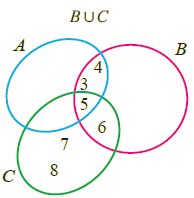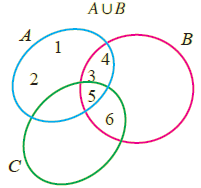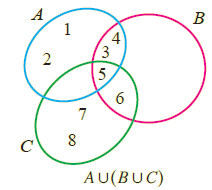ASSOCIATIVE PROPERTY OF SETS
Subscribe to our ▶️ YouTube channel 🔴 for the latest videos, updates, and tips.
Here we are going to see the associative property used in sets.
For any two two sets, the following statements are true.
(i) Set union is associative
A u (B u C) = (A u B) u C
(i) Set intersection is associative
A n (B n C) = (A n B) n C
Let us look at some example problems based on above properties.
Example 1 :
Given, A = {1, 2, 3, 4, 5}, B = {3, 4, 5, 6} and C = {5, 6, 7, 8}, show that
(i) A u (B u C) = (A u B) u C. (ii) Verify (i) using Venn diagram.
Solution :
Now,
B u C = {3, 4, 5, 6} U {5, 6, 7, 8} = {3, 4, 5, 6, 7, 8}
A u (B u C) = {1, 2, 3, 4, 5} u { 3, 4, 5, 6, 7, 8}
= {1, 2, 3, 4, 5, 6, 7, 8} -----(1)
A u B = {1, 2, 3, 4, 5} u {3, 4, 5, 6} = {1,2,3,4,5,6}
(A u B) u C = {1,2,3,4,5,6} u {5,6,7,8}
= {1, 2, 3, 4, 5, 6, 7, 8} ----- (2)
(1) = (2)
 |
 |
 |
 |
Example 2 :
Let A = {a, b, c, d}, B = {a, c, e} and C = {a, e}.
(i) Show that A n (B n C) = (A n B) n C. (ii) Verify (i) using Venn diagram
Solution :
B n C = {a, c, e} n {a, e} = {a, e}
A n (B n C) = {a, b, c ,d} U {a, e}
= { a } -----(1)
A n B = {a, b, c, d} n {a, c, e} = {a, c}
(A n B) n C = {a, c} n {a, e}
= {a} -----(2)
(1) = (2)
 |
 |
 |
 |
Example 3 :
For A = {x ; x is a prime factor of 42}, B = {x | 5 x ≤ 12, x ∊ N} and C = {1, 4, 5, 6}, verify A U (B U C) = (A U B) U C
Solution :
A = {2, 3, 7}, B = {5, 6, 7, 8, 9, 10, 11, 12}, C = {1, 4, 5, 6}
B u C = {5, 6, 7, 8, 9, 10, 11, 12} u {1, 4, 5, 6}
= {1, 2, 4, 6, 8, 9, 10, 11, 12}
A u (B u C) = {2, 3, 7} u {1, 2, 4, 6, 8, 9, 10, 11, 12}
= {1, 2, 3, 4, 6, 7, 8, 9, 10, 11, 12} ----(1)
A u B = {2, 3, 7} u {5, 6, 7, 8, 9, 10, 11, 12}
= {2, 3, 5, 6, 7, 8, 9, 10, 11, 12}
(A u B) u C = {2, 3, 5, 6, 7, 8, 9, 10, 11, 12} u {1, 4, 5, 6}
= {1, 2, 3, 4, 6, 7, 8, 9, 10, 11, 12} ----(2)
(1) = (2)
Subscribe to our ▶️ YouTube channel 🔴 for the latest videos, updates, and tips.
Kindly mail your feedback to v4formath@gmail.com
We always appreciate your feedback.
About Us | Contact Us | Privacy Policy
©All rights reserved. onlinemath4all.com

Recent Articles
-
US Common Core K-12 Curricum Algebra Solving Simple Equations
Jan 07, 26 01:53 PM
US Common Core K-12 Curricum Algebra Solving Simple Equations -
10 Hard SAT Math Questions (Part - 4)
Jan 05, 26 06:56 PM
10 Hard SAT Math Questions (Part - 4) -
10 Hard SAT Math Questions (Part - 3)
Jan 05, 26 06:34 PM
10 Hard SAT Math Questions (Part - 3)

